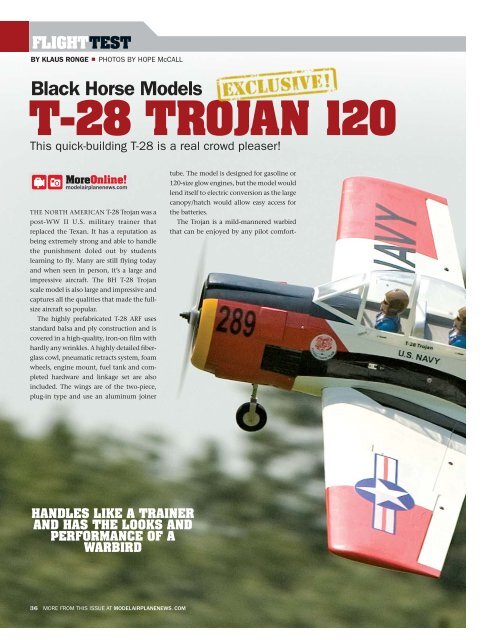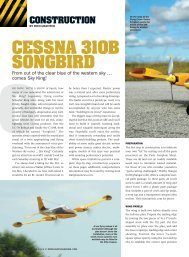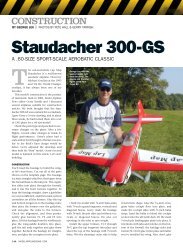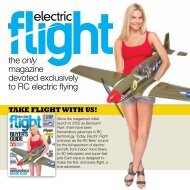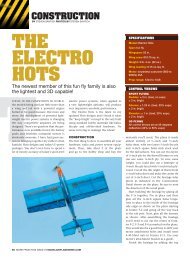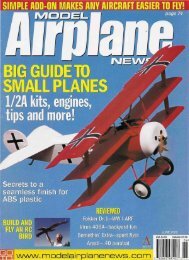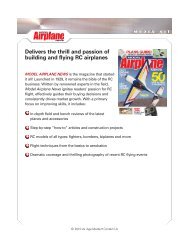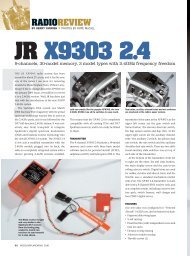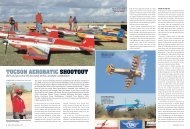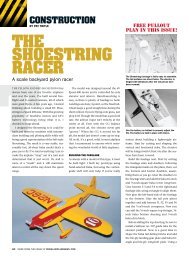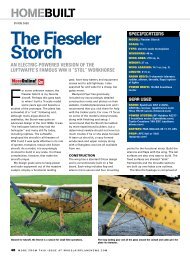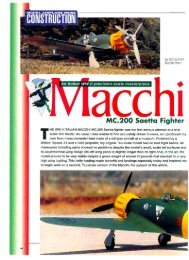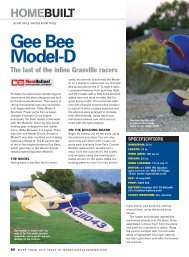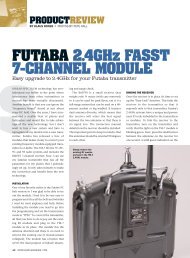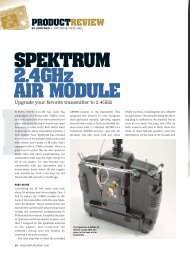t-28 trojan 120 - RC Universe
t-28 trojan 120 - RC Universe
t-28 trojan 120 - RC Universe
Create successful ePaper yourself
Turn your PDF publications into a flip-book with our unique Google optimized e-Paper software.
FLIGHTTEST<br />
BY KLAUS RONGE PHOTOS BY HOPE McCALL<br />
Black Horse Models<br />
T-<strong>28</strong> TROJAN <strong>120</strong><br />
This quick-building T-<strong>28</strong> is a real crowd pleaser!<br />
MoreOnline!<br />
modelairplanenews.com<br />
THE NORTH AMERICAN T-<strong>28</strong> Trojan was a<br />
post-WW II U.S. military trainer that<br />
replaced the Texan. It has a reputation as<br />
being extremely strong and able to handle<br />
the punishment doled out by students<br />
learning to fly. Many are still flying today<br />
and when seen in person, it’s a large and<br />
impressive aircraft. The BH T-<strong>28</strong> Trojan<br />
scale model is also large and impressive and<br />
captures all the qualities that made the fullsize<br />
aircraft so popular.<br />
The highly prefabricated T-<strong>28</strong> ARF uses<br />
standard balsa and ply construction and is<br />
covered in a high-quality, iron-on film with<br />
hardly any wrinkles. A highly detailed fiberglass<br />
cowl, pneumatic retracts system, foam<br />
wheels, engine mount, fuel tank and completed<br />
hardware and linkage set are also<br />
included. The wings are of the two-piece,<br />
plug-in type and use an aluminum joiner<br />
HANDLES LIKE A TRAINER<br />
AND HAS THE LOOKS AND<br />
PERFORMANCE OF A<br />
WARBIRD<br />
36 MORE FROM THIS ISSUE AT MODELAIRPLANENEWS.COM<br />
tube. The model is designed for gasoline or<br />
<strong>120</strong>-size glow engines, but the model would<br />
lend itself to electric conversion as the large<br />
canopy/hatch would allow easy access for<br />
the batteries.<br />
The Trojan is a mild-mannered warbird<br />
that can be enjoyed by any pilot comfort-
able with low-wing aileron sport planes.<br />
Assembly should present no problems for<br />
anyone who has built a few ARFs. Now<br />
instead of months of building a scale model<br />
from a kit or plans, you can enjoy flying<br />
after a week or so. It seems modelers have a<br />
soft spot for T-<strong>28</strong>s as everyone gathered<br />
around the model for the test flight and<br />
gave it many compliments.<br />
UNIQUE FEATURES<br />
I started with the wing panels and each<br />
requires an aileron and flap servo. All the<br />
control surfaces have the hinge slots cut<br />
BLACK HORSE MODELS T-<strong>28</strong> TROJAN <strong>120</strong><br />
and only require an application of CA glue.<br />
I used Y-harnesses for the aileron and flaps;<br />
the flaps are installed so that a reversing<br />
harness is not required. The servos are hidden<br />
under flush-fitting hatches with only<br />
the arm protruding. The control horns for<br />
all flight surfaces consist of 3mm bolts with<br />
a thread-on horn and plastic end caps that<br />
fit into predrilled holes. Wing attachment is<br />
accomplished by tabs secured inside the<br />
fuselage with bolts. After the wing is<br />
attached, the instructions tell you to drill a<br />
hole in the wing spar to accept the included<br />
large wood screw. Instead, I drilled and<br />
SPECIFICATIONS:<br />
MODEL: T-<strong>28</strong> Trojan <strong>120</strong><br />
MANUFACTURER: Black Horse Models<br />
DISTRIBUTOR: Hobby People<br />
(hobbypeople.net)<br />
TYPE: Sport scale ARF<br />
WINGSPAN: 78.7 in.<br />
WING AREA: 945 sq. in.<br />
LENGTH: 63.8 in.<br />
WEIGHT: 13lb., 2oz.<br />
WING LOADING: 36.5 oz./sq. ft.<br />
POWER REQ’D: <strong>120</strong> 2-stroke glow; 20-<br />
23cc gasoline<br />
RADIO REQ’D: 6-channel (rudder,<br />
throttle, aileron, elevator, flaps, retracts)<br />
PRICE: $500<br />
HIGHLIGHTS<br />
■ Great scale model of classic trainer<br />
■ Fast assembly<br />
■ Quality pneumatic retracts included<br />
■ Large size for easy flight characteristics<br />
OCTOBER 2009 37
FLIGHTTEST<br />
CONTROL THROWS<br />
AILERON: ± 5 ⁄8 in., 25% expo<br />
ELEVATOR: ± 5 ⁄8 in., 25% expo<br />
RUDDER: ± 7 ⁄8 in., 25% expo<br />
GEAR USED<br />
RADIO: Airtronics SD-10G 2.4GHz<br />
transmitter, Airtronics 92104 10-channel<br />
receiver, 7 Airtronics 94162Z servos, 2<br />
Airtronics 94112Z servos (throttle and<br />
retracts), JR 2400mAh receiver battery<br />
(airtronics.net, horizonhobby.com)<br />
ENGINE: Magnum XL 1.80RFS 4-stroke<br />
FUEL: Byron 15% (byronfuels.com)<br />
PROP: Graupner 16x8 (graupner.com)<br />
In the Air<br />
When I was asked to test fly the new 1.20-size T-<strong>28</strong> ARF<br />
from BH Models, I couldn’t say no. Having reviewed and<br />
flown the smaller 60-size ARF T-<strong>28</strong> (Model Airplane News<br />
January 2008), I knew this airplane would also be a great<br />
performer.<br />
The Magnum 180 four-stroke provides more than enough<br />
power and takeoffs were uneventful. I flew the first flight with<br />
the retractable landing gear in the down position to shake out<br />
any bugs. Happily, there were none. The airplane flew<br />
flawlessly and was extremely stable. Half flaps were used for<br />
the first two low passes into our 10mph wind. I was very<br />
impressed how slow the Trojan can land in this configuration<br />
and a slight headwind. All control surfaces stayed extremely<br />
effective all the way to the landing flare out.<br />
After checking the airplane over with a thorough post<br />
flight, it was time for another sortie. After the third pass for<br />
the camera with the gear still down, the left main wheel<br />
chose to depart the aircraft. Hmm, I must have forgotten to<br />
check them after the first flight. So for landing, I retracted<br />
the gear and brought her in. With half flaps out and the<br />
gear up, my good friend and spotter Ken Eckstein adjusted<br />
the throttle trim so I could kill the engine just before<br />
touchdown. I greased the belly landing with absolutely no<br />
damage to the airplane. We even found the wheel at the far<br />
end of the runway!<br />
38 MORE FROM THIS ISSUE AT MODELAIRPLANENEWS.COM<br />
BLACK HORSE MODELS T-<strong>28</strong> TROJAN <strong>120</strong><br />
tapped the spar for 6-32 bolts. The main<br />
and nose gear retracts are installed after<br />
snaking the included airlines through their<br />
respective openings. All the fittings are<br />
included for the pneumatic system, but an<br />
air tank is not included. The instructions<br />
show how to fabricate one using an empty<br />
Ensure container, but I used a standard air<br />
tank that I had on hand. I also added a<br />
Robart fill valve (Robart.com) for use with a<br />
compressor or handheld pump.<br />
I am partial to 4-stroke engines and was<br />
fortunate to have the new Magnum XL<br />
1.80RFS (Blue Head) engine. The engine fit<br />
GENERAL FLIGHT PERFORMANCE<br />
Stability The T-<strong>28</strong> Trojan is rock solid throughout the entire flight<br />
envelope.<br />
Tracking There was only minimal throw to the nose wheel, which I<br />
thought might be an issue, but the rudder is very effective with the<br />
application of full throttle. In the air, this thing was straight as an arrow.<br />
Three clicks of aileron and I was flying hands-off at 60% throttle.<br />
Aerobatics Absolutely! This airplane is capable of all normal, scale, non-<br />
3D aerobatic maneuvers. Knife-edge flight had a slight pitch to the gear,<br />
but not bad. Loops were nice and round. Inverted too is a piece of cake.<br />
No issues at all if you are a sport pilot.<br />
Glide and stall performance Phenomenal! Stalls are soft and gentle with<br />
minimal dropping of the left wing tip. The T-<strong>28</strong> is very forgiving and a<br />
predictable flying airplane.<br />
PILOT DEBRIEFING<br />
I can’t say enough for the BH Models scale ARFs, specifically both of their<br />
T-<strong>28</strong> Trojans. The new <strong>120</strong>-size Trojan handles like a trainer and has the<br />
looks and performance of a warbird. The Magnum 180 4-stroke provides<br />
plenty of power for the Trojan. If you are looking to get into larger-size<br />
warbirds, this military trainer is a great choice.<br />
— Aaron Ham
T-<strong>28</strong> Sortie: A Raven’s Tale<br />
Imagine a deep mountain valley with jungle-covered slopes<br />
that cascade in dark green channels down to a solitary<br />
runway. Nights are spent in an old teak-timbered house that,<br />
since 1945, has seen every description of adventurer pass<br />
through its doors. At night, while I sip Johnnie Walker Black and<br />
consider life and its variations, the fog sometimes rolls down the<br />
steep, looming ridges and blankets the valley<br />
floor. It is Long Tiene (“long-chen”) near the<br />
Plain of Jars (PDJ) in northern Laos in late<br />
September 1969.<br />
At dawn, nearly every imaginable aircraft<br />
engine sound, except that of a pure jet, will<br />
shatter the morning stillness. This valley is<br />
also called “Site 20 Alternate,” or just<br />
“Alternate.” Mixed with the howls of the<br />
Pilatus Porter turboprops of Air America and<br />
Continental Air Services and the coughing<br />
splutters of C-123s is the distinctive sound of<br />
the 1425hp Pratt & Whitney R-1820 radial<br />
belonging to the T-<strong>28</strong> aka, the Tango.<br />
A narrow gravel parking area alongside the asphalt<br />
runway holds two T-<strong>28</strong>Ds and half a dozen O-IFs<br />
belonging to the Ravens-volunteer USAF forward air<br />
controllers (FAC) in civilian clothes. There are also six or<br />
eight Royal Lao Air Force (RLAF) T-<strong>28</strong>Ds. Hemming the<br />
aircraft in on three sides are several hundred Mark 82 500pound<br />
bombs—half of them fused—which is about a day’s<br />
expenditure.<br />
The RLAF is often called the “A team,” to distinguish them<br />
from the “B team” who are contracted Thais who fly daily into<br />
Laos to augment the ranks of the beleaguered RLAF. RLAF pilots<br />
graduate from a six-month training course at Udorn Royal Thai<br />
Air Force Base (RTAFB)-taught entirely in the T-<strong>28</strong> B/C/D-and go<br />
directly into combat. Their school, Detachment 1 of the 56th<br />
Special Operations Wing, is on the Air America ramp. At its<br />
inception, the school was called “Waterpump” (across the ramp<br />
is a building housing the Joint Liaison Detachment, the center of<br />
CIA operations and logistics support for operations in Laos).<br />
Detachment 1 also repairs our T-<strong>28</strong>s (although Air America does<br />
some of the tougher jobs) and is the administrative home for the<br />
Ravens. They have about 70 T-<strong>28</strong>s on the ramp, a few<br />
hundred yards and a world away from the<br />
USAF Wing of F-4s and RF-4s on the main<br />
part of the base. The Thais’ contract, we<br />
have found, precludes their working in the<br />
presence of ground fire. This is a sweet<br />
deal for them, but it means that they are<br />
useless for air strikes in Laos, where there<br />
is nothing but ground fire. Our criticism of<br />
the B team’s performance causes the<br />
straphangers in the Air Attaches’ office (the<br />
“downtowners”) in Vientiane to accuse us of<br />
having a bad attitude.<br />
The CIA is known as “the customer,” and<br />
last night, the grayhaired, blue-eyed chief customer gave<br />
me a special job to do before I got into the routine<br />
business of running air strikes all day. A special truck convoy<br />
was coming into Laos from North Vietnam on Route 7, crossing<br />
the border at about 0700. In the convoy of seven, the third<br />
truck, with all it contained, must be destroyed, he said. The<br />
customer was very precise and didn’t explain what the truck<br />
contained. — Karl Polifka<br />
This article appeared in the December 2000 special issue, The<br />
Best of Flight Journal: “Vietnam Air War.” For the entire article,<br />
go to the Members Only page at modelairplanenews.com/mo<br />
OCTOBER 2009 39
FLIGHTTEST<br />
The nose gear retract is straightforward to install. There are no gear doors to<br />
complicate the installation or hang up during installation.<br />
with no problem in the huge cowl with<br />
only the usual cutouts for the cylinder<br />
head, muffler and needle valve required. I<br />
was especially pleased with the cowl as the<br />
dummy radial cylinders are integral to the<br />
unit and have the space between the cylinders<br />
already cut out for you. I drilled several<br />
large holes in the firewall into the nosegear<br />
bay for some additional cooling airflow.<br />
When it came time to install the tailfeathers,<br />
everything lined up perfectly; no<br />
sanding required. The vertical fin includes a<br />
large fillet that sandwiches the horizontal<br />
Radio Control Car<br />
Action editor<br />
Kevin Hetmanski<br />
lends a hand<br />
during ground<br />
running of the<br />
Magnum 1.80 in<br />
preparation for<br />
its first flight.<br />
40 MORE FROM THIS ISSUE AT MODELAIRPLANENEWS.COM<br />
BLACK HORSE MODELS T-<strong>28</strong> TROJAN <strong>120</strong><br />
stabilizer and results in a very strong tail.<br />
Each elevator is controlled by its own servo<br />
located in the radio compartment and actuated<br />
by metal pushrods within preinstalled<br />
tubes. Another feature that I was very<br />
pleased with was the pull-pull cables for the<br />
rudder as they were already installed and<br />
only needed final adjustment. This eliminated<br />
the tedious threading of the cables.<br />
The canopy/hatch comes completely<br />
assembled with the student and instructor<br />
pilots already installed. Another nice touch<br />
is the graphics are already applied.<br />
The radio compartment is huge and the large canopy/hatch provides convenient<br />
access.<br />
CONCLUSION<br />
It took me about 25 hours to complete<br />
the T-<strong>28</strong> since so much of it is already<br />
completed at the factory. The end result<br />
is a very nice, semi-scale model that represents<br />
a great value. The large size<br />
contributes to its stable and solid flight<br />
characteristics, yet the two-piece wing<br />
makes it easy to transport. Whether this<br />
is your first scale project or your tenth,<br />
you’ll be thrilled with this crowd-pleasing,<br />
quick-building and great-flying T-<strong>28</strong><br />
replica.


